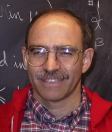The Aspen Center for Physics is a physics retreat in which groups of researchers in a given field gather for a few weeks during the summer to discuss the latest developments and create the next ones. This May, a record four Brandeis physicists — almost a quarter of the department — visited the Center at the same time, attending two different workshops. This posting is about a workshop attended by string theorists Matthew Headrick and Albion Lawrence (and co-organized by Headrick); another posting will describe a workshop attended by condensed-matter theorists Aparna Baskaran and Bulbul Chakraborty (a member of the Center’s advisory board). Entry into Aspen workshops is competitive, so this strong Brandeis representation is remarkable; as always, we punch above our weight.
Headrick and Lawrence attended the workshop Quantum information in quantum gravity and condensed matter physics. This was a highly interdisciplinary workshop, which brought together specialists in quantum gravity, including Headrick and Lawrence; experts in quantum information theory; and experts in “hard” condensed matter physics (who study material properties for which quantum phenomena play a central role).
Quantum information theorists study how the counterintuitive features of quantum mechanics — such as superpositions of states, entanglement between separated systems, and the collapse of the wave function brought on by measurement — could be exploited to produce remarkable (but so far mostly hypothetical) technologies like teleportation of quantum states, unbreakable encryption, and superfast computation. What does this have to do with gravity? When we try to formulate a consistent quantum-mechanical theory of gravity — which would subsume Einstein’s classical general theory of relativity — the concept of information crops up in numerous and often puzzling ways. For example, Stephen Hawking showed in the 1970s that, on account of quantum effects, black holes emit thermal radiation. Unlike the radiation emitted by conventional hot objects, which is only approximately thermal, pure thermal radiation of the kind that Hawking’s calculation predicted cannot carry information. Many physicists (including Hawking) therefore originally interpreted his result as implying that black holes fundamentally destroy information, challenging a sacred principle of physics. Today, based on advances in string theory, physicists (including Hawking) generally believe that in fact black holes do not destroy the information they contain. Rather, black holes hide information in very subtle ways, by scrambling, encryption, and perhaps quantum teleportation — in other words, the same kinds of tricks that the quantum information people have been inventing and studying independently at the same time.
Another connection between gravity and information is provided by the so-called “holographic principle”, which also arose in the study of black holes and which has been given a precise realization in the context of string theory. This principle posits that, due to a combination of gravitational and quantum effects, there is a fundamental limit to the amount of information (i.e. the number of bits) that can be stored in a region of space, and furthermore that limit is related to its surface area, not its volume. String theorists, beginning with the seminal work of Juan Maldacena, have uncovered a number of precise implementations of this principle, in which certain quantum theories without gravity are holograms of theories of quantum gravity. This should provide an avenue for uncovering the “tricks” gravity uses to hide information, a subject Lawrence is active in. An additional benefit of these implementations is that calculations in the nongravitational theories which seemed prohibitively difficult become fairly simple in the gravitational side; these include the computation of interesting quantities in quantum information theory, an area in which Headrick has done influential work.
 All of these issues and many others were discussed in Aspen. This rather unique workshop was a very fruitful exchange of ideas, with physicists from three fields learning from each other and forging new interdisciplinary collaborations, in a setting where the scenery matched the grandeur of the subject.
All of these issues and many others were discussed in Aspen. This rather unique workshop was a very fruitful exchange of ideas, with physicists from three fields learning from each other and forging new interdisciplinary collaborations, in a setting where the scenery matched the grandeur of the subject.



